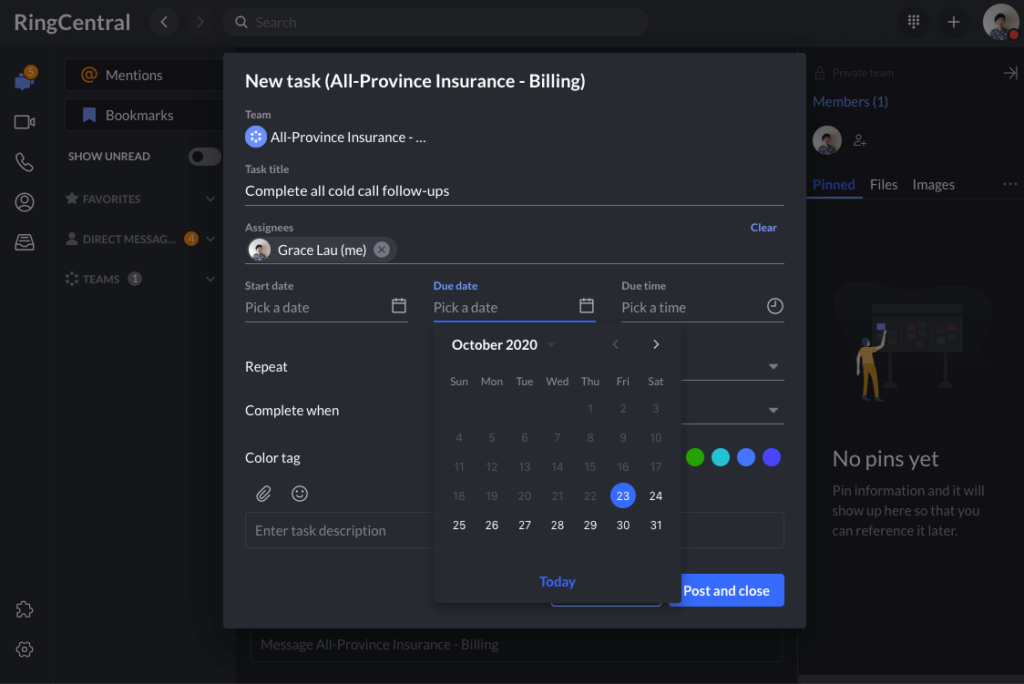We often think of sales pitches as schlocky one-liners from a man in a cheap suit. You know the one: he approaches you and speaks in a way that makes you wonder if you’ve known him for years.
He talks quickly, making his way through a list of points. You’re confused, but find yourself reluctantly agreeing with what he’s telling you.
He turns it up a bit, coming on stronger. You’re still trying to place where you might know this person from.
Was it high school? Is that so-and-so’s friend?
Before you know it, you’re holding a pen, about to sign on the dotted line for something that, mere moments ago, you didn’t even know existed—nevermind wanted.
So what just happened?
You were sold to. And no one likes being sold to.
But here’s the thing. Sales pitches don’t have to be sleazy. In this post, we’re going to explore what that looks like. You’ll learn:
- What a sales pitch is
- 5 key elements of a successful pitch
- 6 sales pitch examples
- 6 tips to improve your pitches
🚀 Start closing more deals with this free outbound sales playbook.
What is a sales pitch?
Basically, a sales pitch is someone’s attempt to persuade you to buy something. Unlike the above example, it’s not about trickery or half-truths—or at least it shouldn’t be.
A good sales pitch identifies a problem or challenge the prospect has, acknowledges the issue, and offers a solution through the product it’s selling, and supports it with proof. The pitch should make the value of the product easy to see.
It’s that—and not the wheeling-and-dealing smooth-talker—that makes someone willing to buy.
5 key elements of a successful sales pitch
Sales pitches can take on many different forms and use different approaches. But when you break them down, they almost always have these five key elements (and it always helps to have good sales apps or cold calling software and a Bluetooth headset if you’re going to be spending hours on calls):
1. The open
The open is the introduction. It’s as simple as saying hello, introducing yourself, and asking the prospect how they are. It’s also your first opportunity to start building rapport. We recommend these conversation starters to break the ice before moving onto the next part.
2. Identification of the problem, pain point, and/or goal
By asking a few different probing questions about their work, you’ll start getting a better understanding of what the prospect’s challenges and goals are. Using active listening (and other empathy exercises), you’ll begin to understand how your product can help address the prospect’s issues in order to reach their goals.
3. Demonstration of value
Once you’ve established rapport and begun to understand the scope of their needs, you can begin to address each one using your product as the solution. You should be able to speak to one or more of their pain points with how your product can solve the problem. Here are a few sales demo best practices.
4. Supporting facts
If you want to build trust, you should be prepared to support your pitch with facts and figures. Consider using social proof, like positive results that show how you beat customer expectations or prove that your other customers got something out of using your product or service.
For example:
- “Our customers save an average of 37% a year on their annual maintenance bills.”
- “Similarly sized businesses have seen a full return on their investment in only three months.”
5. The close
By now, you should’ve clearly shown your prospect the value of your product and how it’s going to make their job or life easier. The close is essentially the point where they say yes and the transaction occurs.
6 examples of sales pitches types
There are countless ways you can pitch to a prospect. But you want to use the right kind of pitch, at the right time, and for the right customer. Below are six different ways to pitch, including an example for each, why it works, and for some, when not to use them.
1. The phone pitch
Believe it or not, the phone call is still the most popular and effective selling channel. With good reason: It’s fast, easy, happens in real-time—and is much harder for your prospect to ignore.
Mark Cuban purchased the Dallas Mavericks in the early 2000s. Probably at a discount because, frankly, they stank. They were rated the worst professional sports franchise of the ‘90s. Naturally, this led to low ticket sales.
So Mark got on the phone and started calling past season ticket holders. And guess what? It worked.
Watch Mark Cuban tell the story about his best phone sales pitch in his own words.
Why did it work?
- He was friendly and built rapport with his prospects.
- He demonstrated value. (A game is less expensive than a meal at McDonald’s. Wowza.)
- He understood that he wasn’t selling a bad team—he was selling a memorable experience.
“But wait, what if I’m on a call with a prospect, but then I want to show them something on my screen?”
Not a problem! There are tools that let you flip between a phone call and video call so that you can do screen sharing if that’s where the conversation takes you. For example, you can do this easily in the RingCentral app (which actually has messaging, video conferencing, and a phone service all in one):
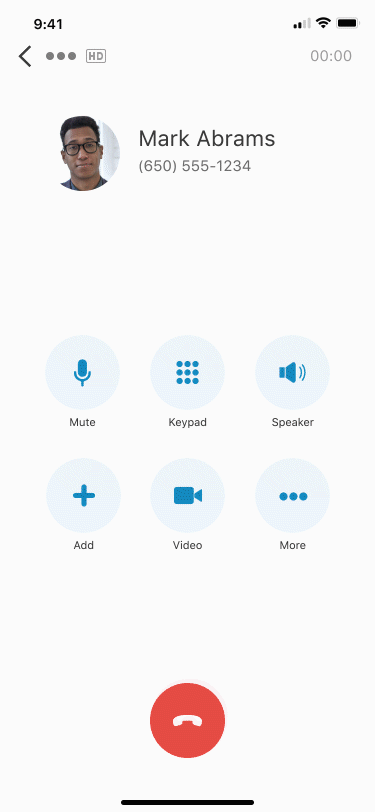
2. The email pitch
Email works. Done well, a good email sales pitch can achieve open rates of 35% or higher. It’s a great way to introduce yourself and your company while demonstrating the value in what you’re selling. But it’s also easy to do poorly. For example, here is the wrong way to pitch via email:
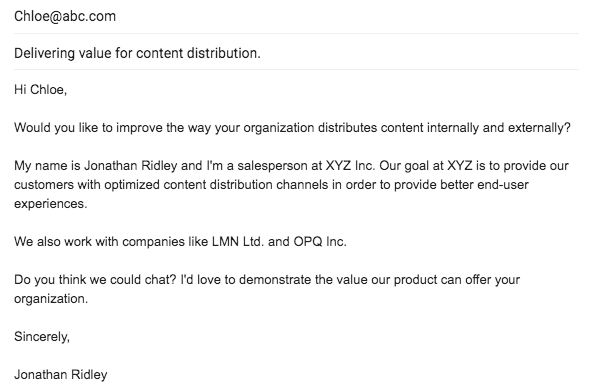
Why this doesn’t work
- The email starts with a hyper-specific question that feels like it’s providing a solution to a problem no one has.
- The value proposition is poorly expressed. What is an “optimized content distribution channel?” What “end-user experiences?”
- The mention of other customers feels more like name-dropping than a good use of social proof. (There’s a better way to do this—see example below.)
- There’s no clear value demonstrated, so it’s very unlikely that Chloe will respond.
A better example from the same person at the same fictional company:
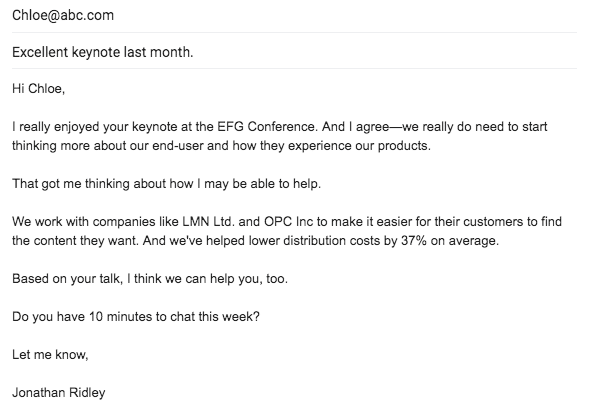
Why this works:
- The pitch starts with a shared experience. In this case, a conference—but it can be any commonality.
- Value is demonstrated clearly and immediately. There’s no ambiguity about what they’re selling and how it helps.
- Social proof is added tactfully.
- Benefits are supported by data.
- The salesperson doesn’t come on too strong.
3. The voicemail pitch
If you work in sales, you’re going to hit a lot of voicemail inboxes. And that’s okay, because successful deals often start with up to eight attempts to actually speak with your prospect. So while hitting an inbox can feel like a miss, don’t be discouraged. It’s actually an opportunity to make an impression and plant a seed before your next attempt.
Example:
Hi [their name]
This is [your name] calling from XYZ company. Sorry I missed you.
I was hoping to speak to you about [reason you’re calling]. We’ve helped other companies [insert benefit] and I think may be able to help you get similar results.
You can reach me at [insert phone number] if you’d like to learn more. But I’ll follow up soon.
Why this works:
- It’s personalized and friendly.
- It doesn’t beat around the bush—the value prop is upfront and center.
- It supports the value prop with previous results.
- It’s short, which is important because otherwise there’s a very good chance the prospect won’t listen to the whole thing.
- It promises to follow up, which will make them expect and be more receptive to another contact.
Oh yeah, and if you say you’re going to follow up within a certain time frame, do it!
The vast majority of deals don’t close in one go, and you have to be both persistent and organized in how you plan your follow-ups. If you know you have a lot of prospects to follow up with, create tasks for yourself (and your team). For example, RingCentral’s desktop and mobile app allows you to not only create team chats for different projects or departments, you can also assign tasks with due dates, relevant files, and even color-coding for easy organization:
4. The deck pitch
If you’re making a pitch in person, congratulations. It means you’ve got a foot in the door, you’re in front of a receptive audience, and half the work is already done. (Although there’s a good chance you did that work. So good job there, too.)
A pitch deck is basically a sales pitch in a presentation format—PowerPoint, Google Slides, or whichever presentation platform you use. They make it easy to tell a story and highlight key points using visual aids that can be very persuasive.
For example, check out this 13-page pitch deck from Castle:
Why it works:
- It states a clear problem that there really should be a solution for.
- It demonstrates how the product solves the problems using key metrics like benefit to customers, growth, and trajectory.
- The messaging is clear and simple.
- The graphics help tell the story, sell the vision, and build brand awareness.
5. The elevator pitch
This type of pitch gets its name from the idea that you should be able to say it in the span of an elevator ride. A good elevator pitch explains what your product does in an extremely concise and effective way.
Take this often-cited example from G2 Crowd
Why it works:
- Instead of repeating the product’s value proposition verbatim, the rep explains what the product does and why it’s useful in words that everyone can understand.
- It’s 21 seconds long—about half an elevator ride in New York City.
6. The follow-up pitch
It’s hard to close a customer on first contact. (Remember, it takes up to eight tries just to get a meeting.) So, focus on getting a shot at a second or third meeting where you’ll have a better understanding of each other and a better chance at closing the deal. The key to a good follow-up pitch is to make it timely and relevant without being a bother.
A good way to do this is to mention a past point of contact or conversation (if you’ve had one).
For example:
“Hi [their name].
It’s [your name] from [your company]. Last time we spoke, you mentioned [problem that the prospect experienced]. I’ve given it some thought and I think I know how I might be able to help you [insert the benefit of your product, as it relates to their problem].”
From there, you can move the conversation forward. Or in the case of an email or voicemail, mention that you’ll follow up again and suggest a time to chat.
Why it works:
- The pitch refreshes their memory and provides context for the conversation.
- It highlights the problem they experienced and how you can solve it.
- It’s appropriate in any scenario—phone call, email, voicemail, or social message.
6 tips to improve your pitches
1. Have the right tools for the job
A phone system can’t pitch for you. But it can make pitching easier. Even better would be an outbound contact center platform that integrates with your customer relationship management (CRM) tool. For example, this is what RingCentral’s looks like:
This will let you make sales calls from your computer, log scripts, see your past conversations with all your accounts, and keep track of conversations you’re having with both prospects and customers. Bottom line: you need some kind of communications tool.
Shameless plug: RingCentral has a whole range of integrations with different CRMs including Agile CRM and Salesforce:
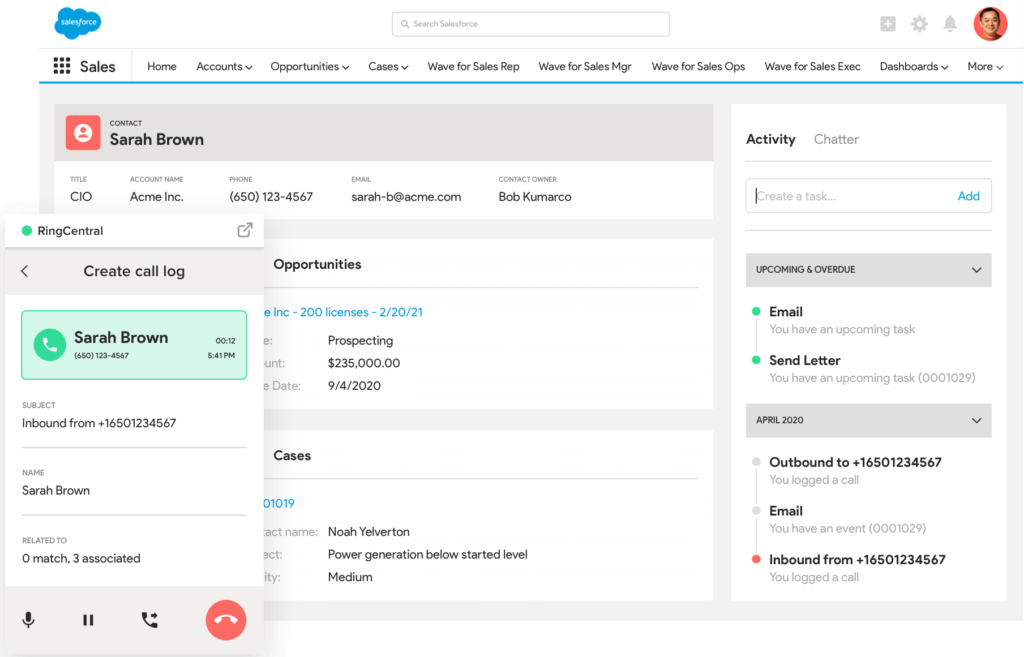
🕹️ Get a hands-on look at how top-performing sales teams are using RingCentral by booking a product tour:
2. Use data to support your claims
Any salesperson can make a big, impressive claim. But the most persuasive salespeople are the ones who can back their claims up with real numbers and customer stories. Where possible, use data to support the benefits of your product. Proof is the most powerful tool in your sales arsenal.
3. Do your research
Gone are the days of picking up a phonebook and dialing prospects without knowing anything about them. Today, to even get a chance to pitch, you need to do your research first. Use LinkedIn to learn more about your prospect. Know their company. Understand what they do. Look at the kind of content they’re posting. It can provide you with enough information to start a conversation worth having.
4. Use a conversation starter
Jumping right into a pitch probably won’t get you very far. Be friendly and build rapport with your prospect first. These sales conversation starters can show you how to move from a “hello” efficiently into your pitch—without sounding too sales-y or coming on too strong.
5. Practice
You have to know your pitch to nail it. So put aside some time to really practice it. Try it out on coworkers. Run through it at home with your spouse. Sit in front of a mirror and pitch to yourself. Have a rebuttal for every objection. Knowing your product and your pitch inside and out is the key to being able to sell with confidence.
6. Talk about benefits, not features
This is the first rule in the book. Your product may have the best features in the world. But they don’t amount to much if they don’t solve your prospect’s problem. Focus on how the benefits of those features address the problems or pain points—and how they can help your customers reach their goals.
What a great sales pitch comes down to…
No one likes feeling like they’re being pressured or hoodwinked in a sales scenario. So we should end the cliche about the smooth-talking salesperson right now.
Instead of approaching a prospect as a target, think of them as someone you can help solve a real problem for.
While there are many ways to pitch a prospect, the most important thing you can do is demonstrate value. Learn what the prospect is struggling with, empathize with their challenges, and find a way to help them overcome the problem that stands in their way.
If you can do that, your prospects will see you as a valued and trusted partner rather than a vendor. And that’s going to make it easier for you to pitch—and close more deals.
Originally published Mar 02, 2020, updated Nov 20, 2023


